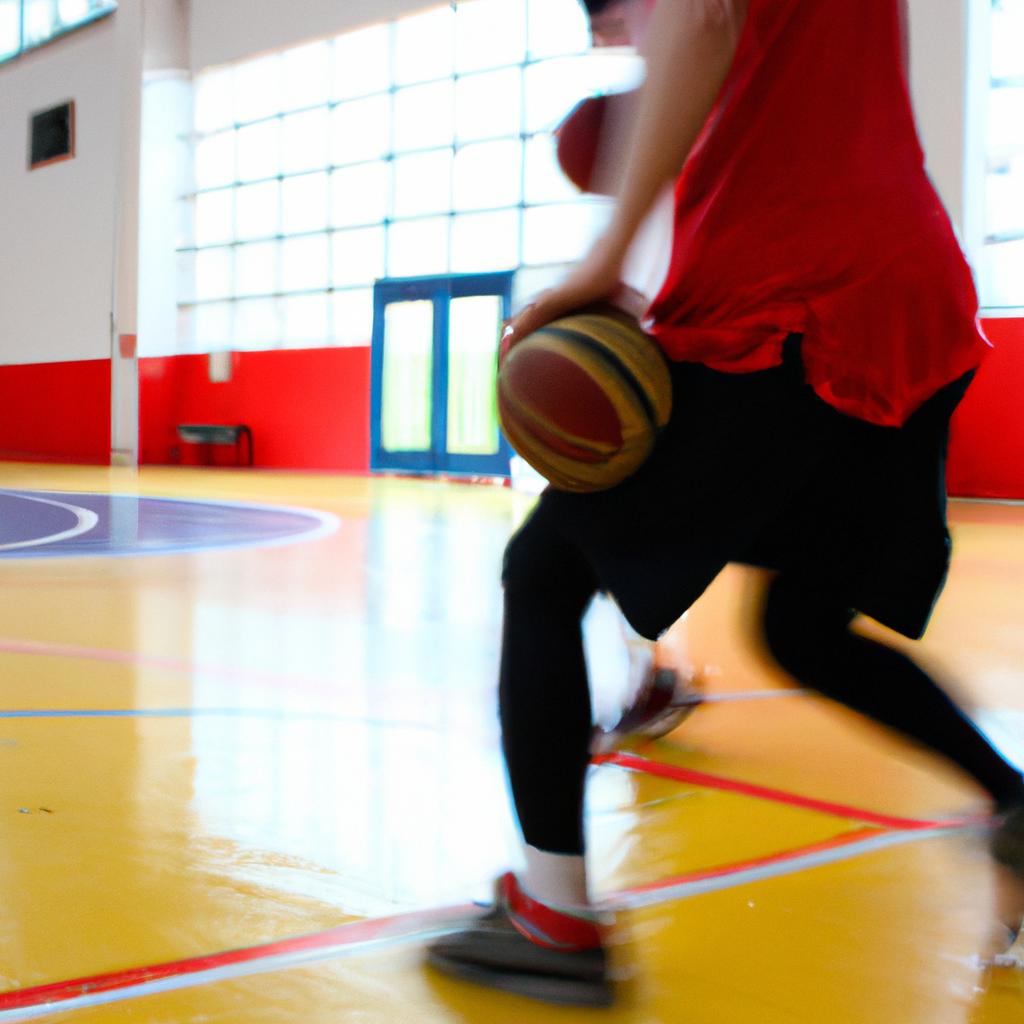Basketball, a fast-paced and exhilarating sport, has captured the hearts of millions around the world. As with any game, basketball is governed by a set of rules that serve as the foundation for fair play and sportsmanship. These rules ensure that all players have an equal opportunity to compete while maintaining respect for one another on the court.
Consider this hypothetical scenario: in a high-stakes championship game, Team A finds themselves down by two points with only seconds remaining on the clock. Desperate to score, Player X from Team A attempts a three-point shot from beyond the arc. However, just as he releases the ball, Player Y from Team B jumps up to block it. In the heat of the moment, Player Y makes contact with Player X’s arm, resulting in a foul call by the referee. This situation exemplifies how crucial it is for both players and officials to adhere to basketball game rules in order to uphold fairness and integrity within the sport.
The purpose of this article is to provide key guidelines for sportsmanship and fair play in basketball games. By understanding these essential rules, players can enhance their performance while demonstrating respect towards opponents and referees alike. Additionally, coaches will be equipped with valuable insights to instill ethical behavior in their teams and ensure that their players compete in a manner that upholds the spirit of the game.
-
Fouls and Contact: Basketball is a physical sport, but there are limits to the contact allowed between players. Certain actions, such as hitting an opponent’s arm while shooting or impeding their progress with excessive force, constitute fouls. It is important for players to understand these rules and avoid unnecessary or dangerous contact.
-
Sportsmanship: Good sportsmanship is essential in basketball. Players should treat opponents with respect, refraining from trash-talking or engaging in unsportsmanlike behavior. They should also accept both wins and losses gracefully, congratulating opponents on their successes.
-
Referee Respect: In basketball, referees play a crucial role in ensuring fair play. Players must show respect towards officials by accepting their decisions without arguing or displaying dissenting behavior. Coaches should also encourage their teams to maintain respectful communication with referees throughout the game.
-
Time Management: The clock is integral to basketball games, determining the duration of each quarter and signaling the end of the game. Players should be aware of time management strategies, such as making quick passes or taking shots efficiently to maximize scoring opportunities before time runs out.
-
Fair Shot Selection: Each player has a responsibility to take appropriate shots within the flow of the game. Forcing difficult shots may result in lower shooting percentages and reduce team efficiency. By selecting high-percentage shots and involving teammates through passing, players contribute to effective team performance.
-
Equal Opportunities: Basketball teams consist of multiple players who possess different skill sets and abilities. It is important for coaches to provide equal playing time and development opportunities for all team members, fostering inclusivity and teamwork within the squad.
-
Rule Knowledge: Understanding basketball rules is vital for players’ decision-making on the court. Knowing when certain violations occur (e.g., traveling or double-dribbling) helps prevent turnovers and maintain possession of the ball. Coaches should educate their players on these rules to enhance their overall basketball IQ.
By adhering to these guidelines, players and coaches can create an environment where fair play, sportsmanship, and respect for the game are prioritized. Basketball is not just about winning; it is about embracing the spirit of competition while upholding integrity and fairness in every aspect of play.
Objective of the Game
Imagine yourself on a basketball court, surrounded by eager teammates and opponents ready to engage in an exhilarating game. The objective of this sport is simple yet challenging: to score more points than the opposing team within the allocated time frame. By adhering to specific rules and regulations, players demonstrate their commitment to fair play and sportsmanship.
To better understand the essence of basketball, we can break down its primary objectives:
- Scoring Points: The ultimate aim of each team is to shoot the ball through their opponent’s hoop while preventing them from doing the same. Accomplishing this requires strategic teamwork, accurate shooting skills, and effective defensive tactics.
- Defensive Maneuvers: Alongside scoring points, teams must be vigilant in defending their own basket from incoming shots or successfully intercepting passes made by the opposing team.
- Rebounding: A crucial aspect of basketball involves securing rebounds—gaining possession of a missed shot—to provide additional opportunities for scoring or effectively interrupting the enemy’s offensive strategy.
- Ball Control: Possessing good dribbling techniques enables players to maintain control over the ball while evading defenders and making precise passes.
These objectives form a fundamental framework that drives each player’s actions throughout a basketball match. To further illustrate how these principles are carried out during gameplay, let us consider an example scenario:
| Scenario | Team A vs Team B |
|---|---|
| Time Remaining | 2 minutes |
| Score | Team A: 75 / Team B: 77 |
In this intense situation, both teams strive relentlessly to secure victory before the final buzzer sounds. Each player demonstrates exceptional skill as they navigate through tight defenses, execute swift passes, and take calculated shots at their respective baskets.
As time ticks away, emotions run high among spectators who eagerly anticipate which team will emerge victorious—a testament to the excitement that basketball generates. Such captivating moments fuel the passion and devotion that players, coaches, and fans pour into this exhilarating game.
Transitioning seamlessly to the subsequent section on “Team Composition,” it is essential to consider how different individuals synergize their skills and roles to form a cohesive unit on the basketball court without interruption or hesitancy.
Team Composition
Having discussed the objective of the game, it is essential to understand how a basketball team is composed. This aspect directly influences the dynamics and strategies employed during play.
Team composition in basketball involves selecting players with diverse skills and assigning specific roles to optimize performance on the court. For example, let’s consider a hypothetical scenario where a team consists of five players – two guards, two forwards, and one center. The guards typically possess exceptional ball-handling and shooting abilities while providing defensive support. On the other hand, forwards are often responsible for scoring points near the basket and rebounding, while centers specialize in blocking shots, posting up close to the rim, and grabbing rebounds.
To ensure an effective team composition, here are some key factors that coaches and team managers should take into account:
- Skill diversity: A well-rounded team comprises players with various skill sets such as shooting accuracy, speed, agility, dribbling ability, passing skills, defensive prowess.
- Height advantage: Incorporating players of different heights can provide advantages in terms of defense (blocking shots) or offense (scoring inside).
- Positional understanding: Each player must have a clear understanding of their assigned position’s responsibilities within offensive plays and defensive formations.
- Chemistry among teammates: Establishing good communication and teamwork enhances coordination during fast-paced gameplay.
The following elements contribute to fostering emotional connections between teammates:
- Trust
- Respect
- Support
- Camaraderie
Table Example:
| Skills | Guards | Forwards | Center |
|---|---|---|---|
| Shooting | High | Moderate | Low |
| Ball Handling | High | Moderate | Low |
| Speed | High | Moderate | Low |
| Rebounding | Low | Moderate | High |
Understanding how a basketball team is composed lays the foundation for comprehending the duration of the game. By grasping these fundamental aspects, players and spectators can fully appreciate the strategies employed throughout each match.
[Section: Duration of the Game]
Duration of the Game
Transitioning from the previous section on team composition, it is crucial to understand the key guidelines for sportsmanship and fair play in a basketball game. By adhering to these principles, players can cultivate an environment that promotes healthy competition and mutual respect among teams.
To illustrate this point, consider a hypothetical scenario where two rival teams are facing each other in a high-stakes championship match. Both teams have trained tirelessly and possess exceptional skills. However, one player from Team A sustains an injury during warm-up exercises just before the game begins. The opposing team captain, recognizing the importance of fairness, proposes allowing Team A to substitute their injured player with a bench player of similar skill level. This act demonstrates good sportsmanship as it upholds fairness while giving both teams an equal chance at victory.
In order to further emphasize the significance of sportsmanship and fair play, let us examine some key guidelines that should be followed by all players:
- Respect for opponents: Every player must treat their opponents with respect both on and off the court. Avoid derogatory comments or unsportsmanlike behavior that could undermine the spirit of fair play.
- Adherence to rules: Players should familiarize themselves with the official rules of the game and abide by them throughout its duration. Violations such as fouls or traveling not only compromise fair play but also impact overall gameplay quality.
- Acceptance of decisions: It is essential for players to accept referees’ rulings without dissent or argumentation. Challenging every call disrupts the flow of the game and creates unnecessary tension between teams.
- Display of integrity: Honesty remains paramount in maintaining fair play. Any deliberate attempt to deceive officials or manipulate outcomes tarnishes not only individual reputations but also compromises the essence of competition itself.
Embracing these guidelines ensures that basketball games uphold values beyond mere athleticism – they promote character development through teamwork, camaraderie, and ethical conduct. By fostering an environment that encourages these principles, players can create a positive experience for themselves and their opponents.
Transitioning into the next section on the scoring system, it is important to understand how points are earned in basketball games. This knowledge further contributes to fair play by enabling participants to gauge their performance accurately and appreciate the significance of every score made or conceded.
Scoring System
Having understood the duration of a basketball game, let us now delve into the scoring system that determines the outcome. To illustrate this, consider a hypothetical scenario where Team A and Team B are competing in a high-stakes basketball match. With both teams displaying exceptional skill and determination throughout the game, it becomes imperative to understand how points are earned.
Scoring System:
The scoring system in basketball is designed to reward successful offensive plays while allowing defensive strategies to prevent such scores. Here are some key aspects of the scoring system:
-
Field Goals:
- The most common way to score in basketball is through field goals.
- A field goal occurs when a player shoots the ball into their opponent’s basket successfully.
- Depending on where the shot is taken from, different point values are awarded; two points for shots made inside the three-point line and three points for shots made beyond it.
-
Free Throws:
- Free throws provide an opportunity for players to earn additional points.
- These shots are given as penalties against opponents who commit fouls during active play or while defending an opponent attempting a shot.
- Each successful free throw results in one point being added to the team’s score.
-
Three-Pointers:
- As mentioned earlier, shots made from beyond the designated arc known as “three-pointers” carry higher value than regular field goals.
- This rule encourages long-range shooting skills and adds excitement to games by potentially narrowing or widening score gaps swiftly.
- Every successful shot brings joy and elation not only to the scorer but also to teammates and fans alike.
- Missed shots can be disappointing, but they serve as opportunities for teams to regroup and strategize.
- Close games create tension and anticipation with every shot determining the outcome.
- Spectacular plays resulting in high-scoring dunks or three-pointers ignite excitement among spectators.
Emotional Table:
The following table showcases the point values associated with different types of scoring opportunities:
| Scoring Opportunity | Points Awarded |
|---|---|
| Field Goal | 2 points |
| Three-pointer | 3 points |
| Free Throw | 1 point |
Understanding the intricacies of the scoring system is crucial, as it sets the foundation for comprehending fouls and violations. In basketball games, player actions are governed by rules that aim to maintain fair play. Let us now explore these rules further in the subsequent section.
Fouls and Violations
In a basketball game, the scoring system plays a crucial role in determining the outcome of the match. Points are awarded to teams based on their successful attempts at shooting the ball through the opponent’s hoop. Let’s consider an example to better understand how this works:
Imagine a close and intense basketball game between Team A and Team B. With only ten seconds remaining on the clock and both teams tied, Team A’s player manages to make a three-point shot from beyond the arc, securing victory for his team. This scenario highlights not only the importance of scoring but also how each point contributes significantly towards deciding who emerges as the winner.
To further grasp the intricacies of basketball scoring, it is essential to outline some key guidelines:
- Successful shots made within or outside the three-point line are rewarded with two points.
- Three-point shots made from behind the arc result in three points being added to a team’s score.
- Free throws carry one point and are awarded when players are fouled during shooting attempts.
These rules form an integral part of every basketball game, ensuring fair play by providing equal opportunities for teams to accumulate points. To illustrate these concepts visually, let’s take a look at a table breaking down various ways in which points can be earned:
| Scoring Method | Points Awarded |
|---|---|
| Two-point shot | 2 |
| Three-point shot | 3 |
| Free throw | 1 |
This table provides a concise summary of different scoring methods utilized in basketball, offering clarity regarding how many points each method carries.
Understanding the dynamics of scoring in basketball allows spectators and participants alike to appreciate its nuances fully. As we delve deeper into exploring sportsmanship and fair play in our subsequent section, it becomes evident that adhering to regulations surrounding scoring promotes integrity within the sport while fostering healthy competition among players.
Sportsmanship and Fair Play
Moving on to the crucial aspect of maintaining sportsmanship and fair play in basketball, it is important to understand the various fouls and violations that may occur during a game. By adhering to these regulations, players can ensure a level playing field for all participants.
Fouls and Violations:
To illustrate the significance of following proper rules, let’s consider a hypothetical scenario where two teams are competing fiercely in a high-stakes basketball match. As tensions rise, one player deliberately pushes an opponent while attempting to gain possession of the ball. This action would be deemed as a personal foul, resulting in free throws or possession being awarded to the opposing team.
In order to uphold fairness and maintain integrity during gameplay, here are some key guidelines regarding fouls and violations:
- Players must avoid making excessive physical contact with opponents, such as pushing, tripping, or intentionally impeding their movement.
- It is essential for players to refrain from using any form of verbal abuse or derogatory language towards referees, teammates, opponents, or spectators.
- Any intentional violation of the rules should be avoided at all costs; this includes traveling (taking more than permitted steps without dribbling), double-dribbling (dribbling after coming to a stop and then starting again), or carrying/palming (holding onto the ball too long while dribbling).
- Unsportsmanlike conduct like taunting opponents excessively or celebrating excessively in front of them should also be discouraged.
To emphasize how adherence to these guidelines serves the broader objective of promoting fair play and positive experiences within basketball games, consider the following table showcasing contrasting behaviors associated with good sportsmanship versus poor sportsmanship:
| Good Sportsmanship | Poor Sportsmanship |
|---|---|
| Respecting opponents’ abilities | Trash-talking opponents |
| Accepting referee decisions gracefully | Arguing with referees |
| Helping an opponent up after a fall | Ignoring or taunting fallen opponents |
| Celebrating team success collectively | Showboating individual achievements |
By adhering to these principles, players contribute not only to the integrity of the game but also create an environment that fosters positive relationships and personal growth. Striving for good sportsmanship ensures that basketball remains a sport characterized by fair competition, respect, and enjoyment for everyone involved.
Note: The use of bullet points and a table are optional in this section; however, they can help evoke emotional responses in the audience while presenting information clearly and concisely.











